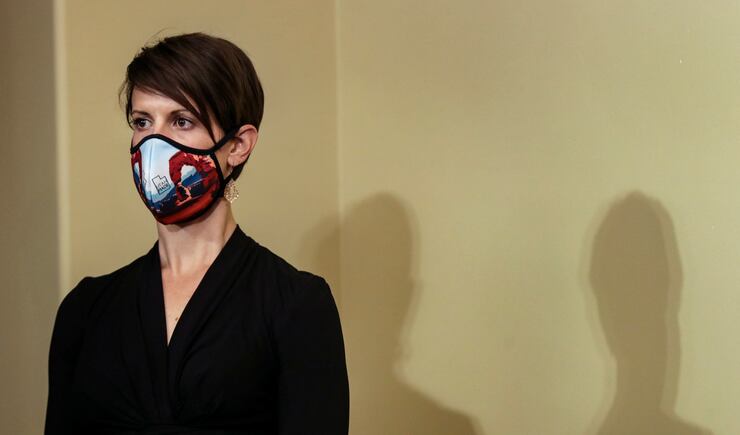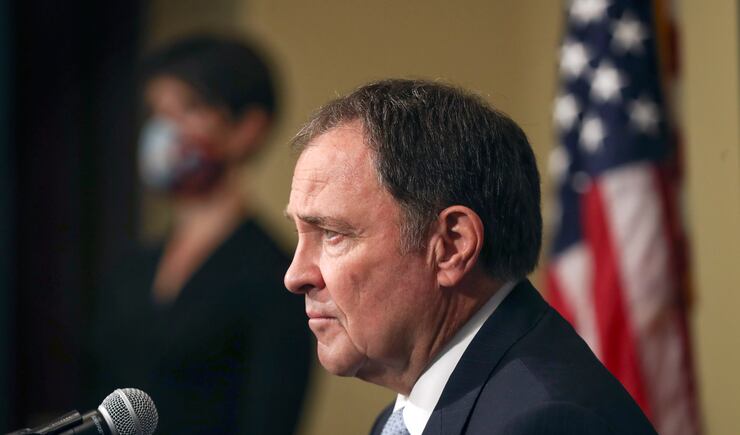SALT LAKE CITY — Another version of Utah’s plan to deal with the ongoing effects of the novel coronavirus was introduced Wednesday by state officials — this time highlighting the state’s most vulnerable populations, including senior citizens and minorities.
“If you are at high risk, it is even more important that you maintain strict social distancing standards, that you practice good hand hygiene, regularly clean and disinfect the surfaces in your home, and stay out of public places as much as possible,” said Dr. Angela Dunn, state epidemiologist with the Utah Department of Health.
She confirmed that 70% of the 90 Utahns who have died with COVID-19 were 65 and older and 90% were 65 and older and/or had underlying conditions.
But, another portion of the population where disparities exist is throughout Utah’s minority and multicultural communities, where infection rates are disproportionate.
“The Utah Leads Together 1.0, 2.0 and 3.0 truly saves lives and livelihoods ... but, (the virus) is not impacting all lives and livelihoods equally,” said Byron Russell, of the Utah Multicultural Commission who was appointed to head up the multicultural subcommittee of Utah’s COVID-19 Community Task Force.
He said that while 14.2% of people in Utah identify as Hispanic or Latino, they make up 38.1% of the state’s total cases of COVID-19.
Native Hawaiians and Pacific Islanders make up 1.6% of the population here, but represent 3.5% of cases, and while there are 2.1% black and African Americans in Utah, 3.2% of cases have been identified in that group.
Furthermore, Russell said these populations experience higher rates of digital divide, food insecurity, misinformation, can have limited English proficiency and access to health care, a lack of culturally inclusive messaging, increased incidents of domestic violence, are homebound with disabilities, housing insecurity, or have a fear of deportation, which complicates response efforts.








Natalie Gochnour, director at the University of Utah’s Kem C. Gardner Policy Institute, said Utah Leads Together 3.0 contains a strategy to address these challenges quickly but maintain flexibility, as “we don’t know what the months ahead look like, for sure.” She said it advises investing now in training and certification initiatives, as well as construction and infrastructure projects to get people back to work.
“Our team believes we’re at the beginning of something new and better for our state,” Gochnour said.
The key to moving to green or no-risk status in Utah, she said, is successfully separating people of low risk and high risk.
“If we can keep them safe, we can have the rest of the population doing different things,” she said.
The latest version addresses the importance of protecting these high-risk populations.
“It does not mince words about the economic challenge that we face,” said Utah Gov. Gary Herbert. “It contains a bold vision of what we can do to accelerate our economic opportunities going forward. I believe at the end of the day, we’ll be as good as we once were and maybe even better.”
Gochnour said even though Utah came into this crisis well prepared, job losses totalling more than 200,000 has dealt an “economic body blow” to the state.
“It is troubling,” she said, but added that the state has “done fairly well.”
“We need to take what we have and get to an even better place,” Gochnour said.
The health department reported 7,710 confirmed cases of COVID-19 in the state on Wednesday, including another two deaths.
New deaths were reported in both Salt Lake and Utah counties. Both individuals, a woman in Utah County and a man in Salt Lake County, were between the ages of 60 and 85 and the woman was a resident at a long-term health care facility, Dunn said.
It brings the total number of Utah fatalities related to COVID-19 to 90.
The number of cases jumped by 192 on Wednesday, a 2.6% growth rate over Tuesday. Since mid-March in Utah, 631 people have been hospitalized with COVID-19, though 100 are currently receiving care at hospitals across the state.
An additional 44 people who are hospitalized are awaiting COVID-19 test results, according to the health department.
The state reports having tested at least 179,664 people for COVID-19 so far, and while Utah has the capacity to test up to 9,000 each day, testing is hovering around 4,000 per day, Herbert said Wednesday. The positive rate is still around 4.2%.
Despite moving most of the state last week to a yellow risk category, or low risk, the governor said there’s still a ways to go.
“I’m not sure we’ll ever get back to what we thought was normal,” Herbert said. “We’re in the middle of an emergency still. We’re not in recovery, but starting to get to that point.”
He said that until the state has the ability to vaccinate against the virus, wearing a mask may be the only way to reduce transmission rates.
“It’s probably the right and proper thing to do,” Herbert said.
Utah, he said, was never shut down and “is getting more open all the time” as officials find the right balance of saving lives, slowing the spread and reopening the economy.
“This will not work, it’ll all be for naught, if people don’t cooperate,” Herbert said, encouraging support for the latest change of plans. He also anticipates Summit and Wasatch counties moving from orange to yellow risk by the end of the week.
Gochnour said, “It doesn’t matter what the government says. It’s really about how you feel.”
She said that if people don’t feel confident that they won’t get sick, they won’t go out and they won’t engage or connect with people and the economy will continue to suffer. Following public health guidance, which includes wearing a face covering in public, Gochnour said, is the quickest way to “getting to green.”
“Stay strong,” Herbert said. “We’ll recover faster than any state in America.”
The latest breakdown of cases, hospitalizations and deaths by health district:
- Salt Lake County, 4,123; 369 hospitalized; 62 deaths.
- Utah County, 1,569; 92 hospitalized; 13 deaths.
- Summit County, 403; 37 hospitalized; 0 deaths.
- Davis County, 386; 32 hospitalized; 2 deaths.
- Southwest Utah, 260; 18 hospitalized; 4 deaths.
- San Juan County, 246; 23 hospitalized; 4 deaths.
- Weber-Morgan, 242; 28 hospitalized; 3 deaths.
- Wasatch County, 217; 10 hospitalized; 1 death.
- Tooele County, 104; 6 hospitalized; 0 deaths.
- Bear River, 93; 13 hospitalized; 1 death.
- Central Utah, 31; 2 hospitalized; 0 deaths.
- TriCounty (Uinta Basin), 20; 1 hospitalized; 0 deaths.
- Southeast Utah, 16; 0 hospitalized; 0 deaths.










